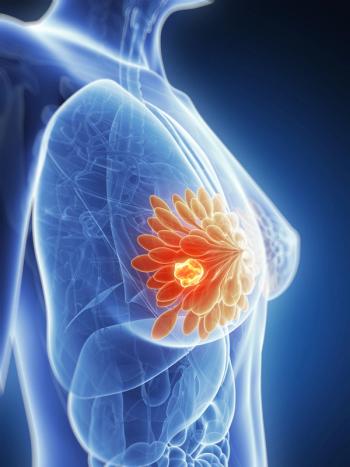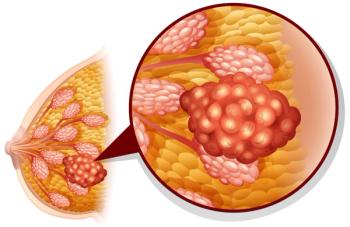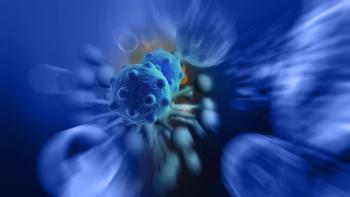
Neoadjuvant Nivolumab/Ipilimumab Shows Superior EFS in Resectable Melanoma
The 24-month RFS rates were 95.1%, 81.2%, 69.4%, and 48.4% in patients with stage III melanoma who experienced a pCR, near pCR, pPR, pNR, respectively.
The combination of nivolumab (Opdivo) and ipilimumab (Yervoy) as neoadjuvant therapy displayed a sustained event-free survival (EFS) and distant metastasis-free survival (DMFS) advantage vs adjuvant nivolumab alone in patients with resectable stage III melanoma, according to 2-year follow-up findings from the phase 3 NADINA trial (NCT04949113), presented at the
At a median follow-up of 25.2 months, updated EFS results from the trial indicated that the 12- and 24-month EFS rates were 85.2% and 77.3% with neoadjuvant (n = 212) therapy, respectively, vs 61.7% and 55.7% with adjuvant therapy (n = 211), respectively (HR, 0.40; 95% CI, 0.28-0.57; P <.001). The updated 12- and 24-month DMFS rates were 88.5% and 82.8% with neoadjuvant therapy, respectively, vs 71.9% and 63.9% with adjuvant therapy, respectively (HR, 0.43; 95% CI, 0.29-0.64; P <.001).
What is the history of PD-1 checkpoint blockade with or without CTLA4 inhibition in NADINA?
Neoadjuvant PD-1 checkpoint blockade with or without CTLA4 inhibition has been shown to improve EFS vs adjuvant PD-1 inhibition in patients with resectable, macroscopic stage III melanoma.2 At a median follow-up of 9.9 months, the NADINA trial previously showed estimated 12-month EFS [rates] of 83.7% (99.9% CI, 73.8%-94.8%) and 57.2% (99.9% CI, 45.1%-72.7%) with neoadjuvant nivolumab plus ipilimumab and adjuvant nivolumab, respectively.2 Moreover, TMB, the 10-gene IFN-γ signature, and PD-L1 expression has demonstrated predictive capability in phase 2 neoadjuvant trials, Lukas explained.
The NADINA trial enrolled patients with stage III de novo or recurrent pathologically proven resectable melanoma with at least 1 lymph node metastasis, 3 or fewer in-transit metastases, and no prior exposure to PD-1, CTLA4, LAG3, or BRAF and MEK inhibition.
Patients were randomly assigned to 1 of 2 arms. In the experimental arm, patients received 2 courses of 80 mg of ipilimumab plus 240 mg of nivolumab every 3 weeks, followed by therapeutic lymph node dissection (TLND); patients with major pathologic response (MPR) entered follow-up and those without received 11 courses of nivolumab at a dose of 480 mg every 4 weeks if BRAF wild-type or 46 weeks of dabrafenib (Tafinlar) at 150 mg twice daily plus trametinib (Mekinist) at 2 mg once daily with or without adjuvant radiation if BRAF V600E/K mutant within 12 weeks of surgery. Patients in the control arm received TLND followed by 480 mg of nivolumab within 12 weeks of surgery every 4 weeks with or without adjuvant radiotherapy.
Patients were stratified for BRAF mutational status, their continent, and the presence of in-transit metastases.
The primary end point was EFS.
What subgroup data were presented during ESMO 2025?
Additional data were presented with respect to recurrence-free survival (RFS) and DMFS according to pathologic response in the neoadjuvant arm. The 24-month RFS rates were 95.1%, 81.2%, 69.4%, and 48.4% in patients with pathologic complete response (pCR), near pCR, pathologic partial response (pPR), and pathologic non-response (pNR), respectively (P = .001). The 24-month DMFS rates were 98.0%, 81.2%, 78.5%, and 55.0%, respectively (P < .001).
RFS was further elucidated according to adjuvant treatment after pPR or pNR in the neoadjuvant arm. A total of 212 patients received neoadjuvant therapy: 129 achieved MPR, 74 achieved pPR/pNR, 6 experienced progression, and 3 were non-evaluable. Within the three respective arms, 43 received adjuvant dabrafenib/trametinib, 21 received adjuvant nivolumab, and 10 received no adjuvant therapy.
The 12-month RFS rates in the dabrafenib/trametinib, nivolumab, and no treatment arms were 85.1%, 75.0%, and 52.4%, respectively. The respective 24-month RSF rates were 67.2%, 58.3%, and 37.7%. “Patients with pCR have very favorable EFS and DMFS at 24 months,” Lukas said.
Pathologic response was also evaluated in the neoadjuvant arm according to baseline TMB, IFN-γ signature, and PD-L1 expression. pCR, near pCR, pPR, pNR, and progression occurred in 61.0%, 6.8%, 6.8%, 23.7%, and 1.7% of patients with high TMB (n = 59), respectively, vs 35.9%, 17.9%, 7.7%, and 32.1%, and 5.1% of those with low TMB (n = 78); 1.3% of patients were not evaluable in the low TMB cohort (P = .006).
pCR, near pCR, pPR, pNR, and progression occurred in 58.1%, 16.2%, 5.4%, 17.6%, and 1.4% of patients with high IFN-γ (n = 74), respectively, vs 30.5%, 10.2%, 10.2%, 42.4%, and 6.8% of those with high IFN-γ (n = 59); 1.4% of patients were not evaluable in the high IFN-γ cohort (P = .002).
pCR, near pCR, pPR, pNR, and progression occurred in 58.6%, 14.3%, 7.1%, 17.1%, and 0% of patients with positive (≥ 1%) PD-L1 expression (n = 70), respectively, vs 38.3%, 11.7%, 8.3%, 36.7%, and 5.0% of those with negative PD-L1 expression (< 1%; n = 60); 2.9% of patients were not evaluable in the positive PD-L1 expression cohort (P = .045).
“Baseline IFN-γ signature, PD-L1 expression and TMB were associated with EFS in the neoadjuvant arm and the IFN-γ signature and PD-L1 expression also in the adjuvant arm. The neoadjuvant arm was superior [to] the adjuvant arm across all biomarker subgroups,” Minke W. Lucas, MD, of the Department of Medical Oncology at the Netherlands Cancer Institute in Amsterdam, Netherlands, said.
The 12- and 24-month EFS rates were 93.2% and 87.7%, 65.4% and 74.0%, 66.8% and 72.1%, and 36.6% and 43.9%, respectively, in the neoadjuvant/IFN-γ-high (n = 74), neoadjuvant IFN-γ-low (n = 59), adjuvant IFN-γ high (n = 85), and adjuvant IFN-γ low (n = 67) populations, respectively (P <.0001).
The 12- and 24-month EFS rates were 92.9% and 87.6%, 79.6% and 73.3%, 74.7% and 67.2%, and 32.0% and 32.0%, respectively, in the neoadjuvant/PD-L1–positive (n = 70), neoadjuvant/PD-L1–negative (n = 60), adjuvant PD-L1–positive (n = 61), and adjuvant/PD-L1–negative (n = 51) populations, respectively (P <.0001).
The 12- and 24-month EFS rates were 91.5% and 91.5%, 76.5% and 62.0%, 66.3% and 59.5%, and 56.5% and 49.3%, respectively, in the neoadjuvant/TMB high (n = 59), neoadjuvant/TMB low (n = 78), adjuvant TMB high (n = 58), and adjuvant/TMB low (n = 94) populations, respectively (P <.0001).
The combination of baseline biomarkers in the adjuvant arm also provided predictive information.
In the neoadjuvant setting, the 12- and 24-month EFS rates were 96.4% and 96.4%, 89.3% and 78.5%, 88.5% and 88.5%, and 61.1% and 45.7%, respectively, in the IFN-γ-high/TMB high (n = 28), IFN-γ-high/TMB low (n = 38), IFN-γ-low/TMB high (n = 26), and IFN-γ-low/TMB low (n = 29) populations, respectively (P < .0001).
The 12- and 24-month EFS rates were 100.0% and 100.0%, 89.5% and 80.5%, 84.6% and 84.6%, and 61.5% and 43.1%, respectively, in the PD-L1–positive/TMB high (n = 21), PD-L1–positive/TMB low (n = 17), PD-L1–negative/TMB high (n = 31), and PD-L1–negative/TMB low (n = 25) populations, respectively (P = .0017).
In the adjuvant setting, the 12- and 24-month EFS rates were 76.2% and 72.7%, 70.8% and 63.8%, 52.2% and 45.7%, and 36.8% and 28.0%, respectively, in the IFN-γ-high/TMB high (n = 31), IFN-γ-high/TMB low (n = 49), IFN-γ-low/TMB high (n = 23), and IFN-γ-low/TMB low (n = 39) populations, respectively (P = .00036).
The 12- and 24-month EFS rates were 80.0% and 80.0%, 70.0% and 54.4%, 50.0% and 50.0%, and 20.0% and 20.0%, respectively, in the PD-L1–positive/TMB high (n = 21), PD-L1–positive/TMB low (n = 17), PD-L1–negative/TMB high (n = 31), and PD-L1–negative/TMB low (n = 25) populations, respectively (P < .0001).
With respect to updated safety data, 97.6% of patients in the neoadjuvant arm (n = 212) experienced an AE (grade ≥3, 49.5%) vs 97.6% (grade ≥3, 39.1%) of those in the adjuvant arm (n = 207). Surgery-related AEs also occurred in the neoadjuvant (any grade, 75.9%; grade ≥3, 14.8%) and adjuvant (any grade, 81.2%; grade ≥3, 16.4%) arms.
Systemic treatment-related AEs occurred in 87.7% (grade ≥3, 31.1%) and 84.1% (grade ≥3, 15.9%) of patients in the neoadjuvant and adjuvant arms, respectively. AEs leading to discontinuation occurred in 9.4% and 18.4% of patients in the neoadjuvant and adjuvant arms, respectively.
One death due to a treatment-related AE occurred in the adjuvant arm.
“Combining IFN-γ and TMB or PD-L1 and TMB further discriminates favorable and unfavorable subgroups in the neoadjuvant and adjuvant arm,” Lucas said in conclusion.
Disclosures: Lucas had no disclosures to report.
References
- Lucas MW, Menzies AM, Dimitriadis P, et al. Two-year clinical update and first biomarker analyses of the phase 3 NADINA trial comparing neoadjuvant nivolumab plus ipilimumab versus adjuvant nivolumab in resectable stage III melanoma. Presented at: 2025 ESMO Congress; October 17-25, 2025; Berlin, Germany. Abstract LBA57.
- Blank CU, Lucas MW, Scolyer RA, et al. Neoadjuvant nivolumab and ipilimumab in resectable stage III melanoma. N Engl J Med. 2024;391(18):1696-1708. doi:10.1056/NEJMoa2402604
Newsletter
Stay up to date on recent advances in the multidisciplinary approach to cancer.





















































































